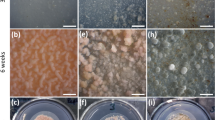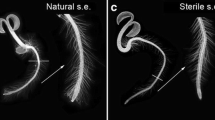Abstract
Methylotrophic bacteria inhabit the surface of plant organs, but the interaction between these microbes and their host cells is largely unknown. Protonemata (gametophytes) of the moss Funaria hygrometrica were cultivated in vitro under axenic conditions and the growth of the protonemal filaments recorded. In the presence of methylobacteria (different strains of Methylobacterium), average cell length and the number of cells per filament were both enhanced. We tested the hypothesis that auxin (indole-3-acetic acid, IAA), secreted by the epiphytic bacteria and taken up by the plant cells, may in part be responsible for this promotion of protonema development. The antiauxin parachlorophenoxyisobutyric acid (PCIB) was used as a tool to analyze the role of IAA and methylobacteria in the regulation of cell growth. In the presence of PCIB, cell elongation and protonema differentiation were both inhibited. This effect was compensated for by the addition of different Methylobacterium strains to the culture medium. Biosynthesis and secretion of IAA by methylobacteria maintained in liquid culture was documented via a colorimetric assay and thin layer chromatography. Our results support the hypothesis that the development of Funaria protonemata is promoted by beneficial phytohormone-producing methylobacteria, which can be classified as phytosymbionts.




Similar content being viewed by others
References
Christianson ML (1996) Morphogenesis and the coordination of cell division in the bryophytes. Semin Cell Dev Biol 7:881–889
Chung KR, Shilts T, Ertürk Ü, Timmer LW, Ueng PP (2003) Indole derivatives produced by the fungus Colletotrichum acutatum causing lime anthracnose and postbloom fruit drop of citrus. FEMS Microbiol Lett 226:23–30
Ehmann A (1977) The van Urk-Salkowski reagent—a sensitive and specific chromogenic reagent for silica thin-layer chromatographic detection and identification of indole derivatives. J Chromatogr 132:267–276
Frank W, Decker EL, Reski R (2005) Molecular tools to study Physcomitrella patens. Plant Biol 7:220–227
Glickmann E, Dessaux Y (1995) A critical examination of the specificity of the Salkowski reagent for indolic compounds produced by phytopathogenic bacteria. Appl Environ Microbiol 61:793–796
Holland MA (1997) Methylobacterium and plants. Recent Res Dev Plant Physiol 1:207–213
Hornschuh M, Grotha R, Kutschera U (2002) Epiphytic bacteria associated with the bryophyte Funaria hygrometrica: effects of Methylobacterium strains on protonema development. Plant Biol 4:682–687
Koenig RL, Morris RO, Polacco JC (2002) tRNA is the source of low-level trans-Zeatin production in Methylobacterium spp. J Bacteriol 184:1832–1842
Kutschera U (2003) Auxin-induced cell elongation in grass coleoptiles: a phytohormone in action. Curr Top Plant Biol 4:27–46
Kutschera U (2006) Acid growth and plant development. Science 311:952–953
Kutschera U, Koopmann V (2005) Growth in liverworths of the Marchantiales is promoted by epiphytic methylobacteria. Naturwissenschaften 92:347–349
Kutschera U, Niklas K J (2005) Endosymbiosis, cell evolution, and speciation. Theory Biosci 124:1–24
Lehnert B, Bopp M (1983) The hormonal regulation of protonema development in mosses I. Auxin-cytokinin interaction. Z Pflanzenphysiol 110:379–391
Lindow SE, Brandl MT (2003) Microbiology of the phyllosphere. Appl Environ Microbiol 69:1875–1883
Ona O, Impe JV, Prinsen E, Vanderleyden J (2005) Growth and indole-3-acetic acid biosynthesis of Azospirillum brasiliense Sp245 is environmentally controlled. FEMS Microbiol Lett 246:125–132
Oono Y, Ooura C, Rahman A, Aspuria ET, Hayashi K, Tanaka A, Uchimiya H (2003) p-Chlorophenoxyisobutyric acid impairs auxin response in Arabidopsis roots. Plant Physiol 133:1135–1147
Reski R (1998a) Development, genetics and molecular biology of mosses. Bot Acta 111:1–15
Reski R (1998b) Physcomitrella and Arabidopsis: the David and Goliath of reverse genetics. Trends Plant Sci 3:209–210
Reski R (2005) Do we need another model plant? Plant Biol 7:219
Scherp P, Grotha R, Kutschera U (2001) Occurrence and phylogenetic significance of cytokinesis-related callose in green algae, ferns and seed plants. Plant Cell Rep 20:143–149
Sood S, Hackenberg D (1979) Interaction of auxin, antiauxin and cytokinin in relation to the formation of buds in moss protonemata. Z Pflanzenphysiol 91:385–397
Weijers D, Jürgens G (2004) Funneling auxin action: specificity in signal transduction. Curr Opin Plant Biol 7:687–693
Wilson M, Lindow SE (1994) Coexistence among epiphytic bacterial populations mediated through nutritional resource partitioning. Appl Environ Microbiol 60:4468–4477
Author information
Authors and Affiliations
Corresponding author
Rights and permissions
About this article
Cite this article
Hornschuh, M., Grotha, R. & Kutschera, U. Moss-associated methylobacteria as phytosymbionts: an experimental study. Naturwissenschaften 93, 480–486 (2006). https://doi.org/10.1007/s00114-006-0137-7
Received:
Revised:
Accepted:
Published:
Issue Date:
DOI: https://doi.org/10.1007/s00114-006-0137-7




